Naebang-gasa
Type
Ibyeolga-ryu (離別歌類)
It is one of Gasa-ryu (type) in which a writer misses a parted lover or is sad about parting with friends and relatives. The sadness of parting is revealed, ending with a promise to meet again.
Gunsanwolniaewonga
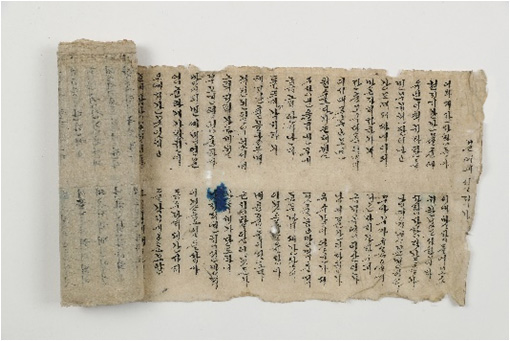 Gunsanwolniaewonga / Early 20th century / 24.5×872.0㎝
It was included in one book along with “Daemyeongboksuga,” “Daphaejosaga,” “Gyoyeoga.” “Chilsyeokga,” and “Gungyeogara.” It is the transcribed copy that does not differentiate between columns and rows, and takes a prose format. “Gunsanwolaewonga” was included in “Byeolgyosa.” Gunsanwol (君山月), the protagonist of the story, is a prostitute (Ginyeo, 妓女) in Myeongcheon (明川), Hamgyeong-do, who shows up in “Bucheonga,” Yubaegasa of Cheongoei (晴葨) Kim Jin-hyeong (金鎭衛), the official of Josonjo Cheoljongdae. She served Cheongoei (晴葨) during his exile in Myeongcheon, Hamgyeong-do. When he was released, she followed him but was left as he changed his mind. “Gunsanwolaewonga” represents this unclear parting process that Kin Jin-hyeong did not reveal in Bukcheonga (北遷歌) with “Gunsanwol” as the speaker. In this transcribed copy, much of the end in the original piece is omitted.
Gunsanwolniaewonga / Early 20th century / 24.5×872.0㎝
It was included in one book along with “Daemyeongboksuga,” “Daphaejosaga,” “Gyoyeoga.” “Chilsyeokga,” and “Gungyeogara.” It is the transcribed copy that does not differentiate between columns and rows, and takes a prose format. “Gunsanwolaewonga” was included in “Byeolgyosa.” Gunsanwol (君山月), the protagonist of the story, is a prostitute (Ginyeo, 妓女) in Myeongcheon (明川), Hamgyeong-do, who shows up in “Bucheonga,” Yubaegasa of Cheongoei (晴葨) Kim Jin-hyeong (金鎭衛), the official of Josonjo Cheoljongdae. She served Cheongoei (晴葨) during his exile in Myeongcheon, Hamgyeong-do. When he was released, she followed him but was left as he changed his mind. “Gunsanwolaewonga” represents this unclear parting process that Kin Jin-hyeong did not reveal in Bukcheonga (北遷歌) with “Gunsanwol” as the speaker. In this transcribed copy, much of the end in the original piece is omitted.
Dapsachinga
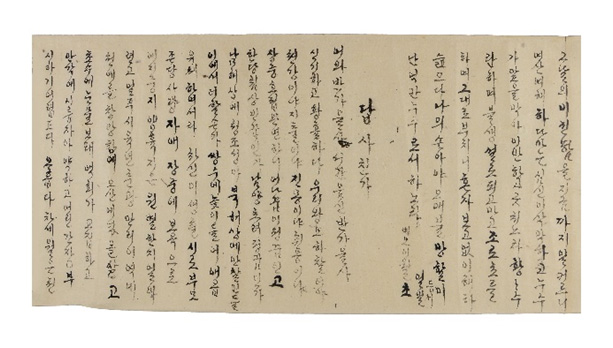 Dapsachinga / Early 20th century / 22.5×620cm
It is included with Josonbyeolseo.
Dapsachinga / Early 20th century / 22.5×620cm
It is included with Josonbyeolseo.
A granddaughter who was married and moved to Hahoe Village from the Goseong Yi family sings about the joy of receiving her grandmother’s letter from Manchuria and misfortune of the destroyed country. She talks about her sad feelings for the two times of the asylum of the Goseong Yi family to Manchuria. She also prays for the recovery of the national luck. The situation of the destroyed country is well represented.
Sangsagyeolgokira
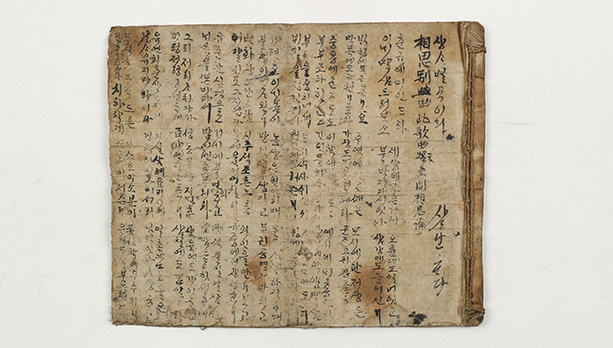 Sangsagyeolgokira / 1835 (The year of Eulmi) / 21.2×26.2㎝
The piece describes the heart of loving and missing the lover and states the wish of being born again to see the significant other if there is some remaining feeling as it is difficult to come back after death. At the end, the writer explains the reason why she wrote this piece: “Don’t laugh as there are swear words in this piece because it is written by a commoner. Laugh as hard as you can after reading it. I will murder you. Thus, do not laugh at this.”
Sangsagyeolgokira / 1835 (The year of Eulmi) / 21.2×26.2㎝
The piece describes the heart of loving and missing the lover and states the wish of being born again to see the significant other if there is some remaining feeling as it is difficult to come back after death. At the end, the writer explains the reason why she wrote this piece: “Don’t laugh as there are swear words in this piece because it is written by a commoner. Laugh as hard as you can after reading it. I will murder you. Thus, do not laugh at this.”
Songbyeoldapga
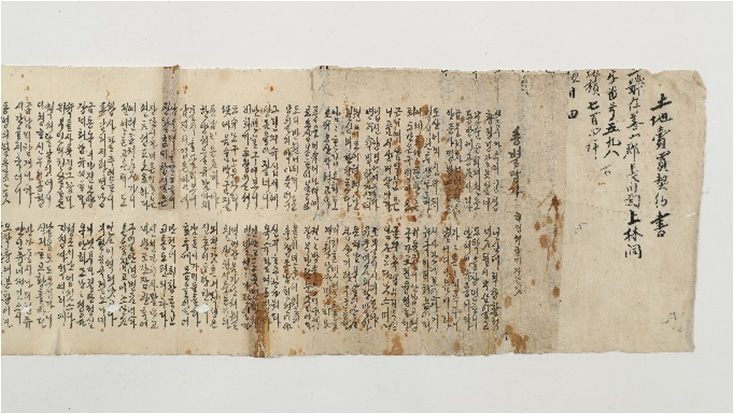 Songbyeoldapga / Mid 1900’s / 24.0×248.0㎝
The lyrics are written in response to the farewell song sent by Jongje after meeting up with Jongban such as Yecheon Jongje and Gilanjeongsil in Seoul and seeing Changgyeongwon and Namsan. At the end, the writer wishes for Chaun several times and states the total number of pieces. A land sales contract is included in the title section.
Songbyeoldapga / Mid 1900’s / 24.0×248.0㎝
The lyrics are written in response to the farewell song sent by Jongje after meeting up with Jongban such as Yecheon Jongje and Gilanjeongsil in Seoul and seeing Changgyeongwon and Namsan. At the end, the writer wishes for Chaun several times and states the total number of pieces. A land sales contract is included in the title section.
Wonbyeolga
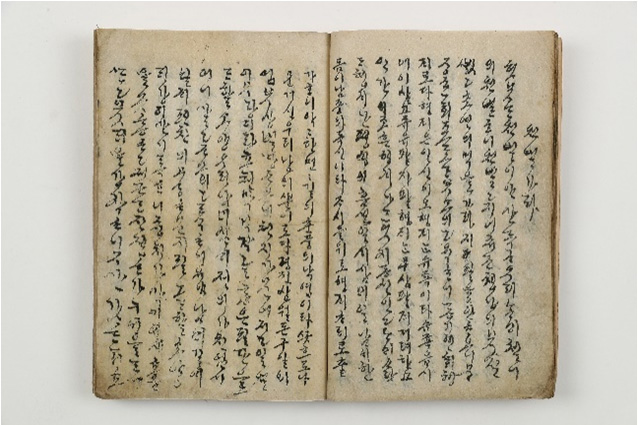 Wonbyeolga / 1927 / 28.3×19.8㎝
The lyrics are about the sadness of parting when the writer’s sister is getting married. In the first half, she laments the fact that none of the 4 siblings are married yet after their parents passed away and they have no one to depend on. After that, she talks about how she feels to part with a younger sister as the sister gets married and advise to live with no regret as the descendant of Hoejae.
Wonbyeolga / 1927 / 28.3×19.8㎝
The lyrics are about the sadness of parting when the writer’s sister is getting married. In the first half, she laments the fact that none of the 4 siblings are married yet after their parents passed away and they have no one to depend on. After that, she talks about how she feels to part with a younger sister as the sister gets married and advise to live with no regret as the descendant of Hoejae.
Wonbyeoldapga
 Wonbyeoldapga / 1960 (The year of Gyeongja) / 17.0×359.6㎝
It is a response to Ibyeolga. It takes place in Shugokchon (Sugokchon), the area of the Jeonju Ryu family, and talks about the sadness of parting.
Wonbyeoldapga / 1960 (The year of Gyeongja) / 17.0×359.6㎝
It is a response to Ibyeolga. It takes place in Shugokchon (Sugokchon), the area of the Jeonju Ryu family, and talks about the sadness of parting.
Wonbyeoldapga
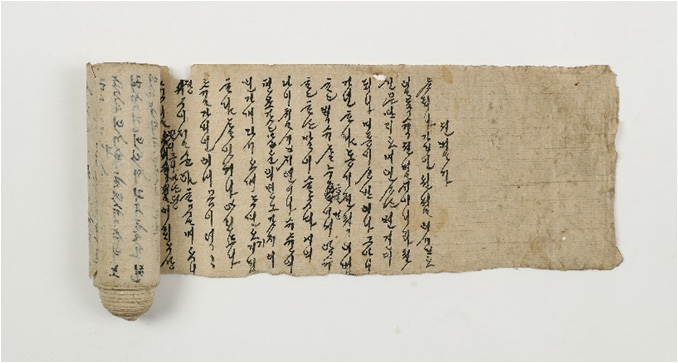 Jeonbyeolga / 1914 (the year of Gapip) / 16.2×404.8㎝
The writer is sad and writes about parting with her siblings and relatives in her hometown.
Jeonbyeolga / 1914 (the year of Gapip) / 16.2×404.8㎝
The writer is sad and writes about parting with her siblings and relatives in her hometown.
Josonbyeolseo
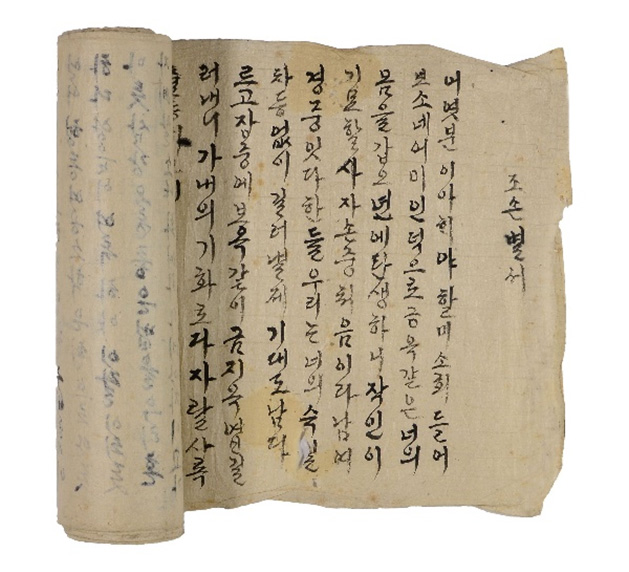 Josonbyeolseo / Early 20th century / 23.0×554.5㎝
The grandmother talks to her beautiful granddaughter. It is written by Kim U-rak, the wife of Seokju Yi Sang-ryong. She sent it to her granddaughter on her way to Manchuria after leaving Andong in 1911, telling the granddaughter greetings and stories. It includes different emotions along with the family history: the joy from the time when the granddaughter was born, the sad feeling from the time when she was getting married, the happiness when she came home, and sadness when they had to part again. Especially when the writer had to leave the country due to the grandfather’s decision, she feels great sorrow from parting with the granddaughter. The ending is about how she still misses the granddaughter so much as they can’t meet with each other, and wishes her to grow up and become a great person. It is included in one scroll along with Dapsachinga, and the inscription date is shown in the end as February of the year of Gabo.
Josonbyeolseo / Early 20th century / 23.0×554.5㎝
The grandmother talks to her beautiful granddaughter. It is written by Kim U-rak, the wife of Seokju Yi Sang-ryong. She sent it to her granddaughter on her way to Manchuria after leaving Andong in 1911, telling the granddaughter greetings and stories. It includes different emotions along with the family history: the joy from the time when the granddaughter was born, the sad feeling from the time when she was getting married, the happiness when she came home, and sadness when they had to part again. Especially when the writer had to leave the country due to the grandfather’s decision, she feels great sorrow from parting with the granddaughter. The ending is about how she still misses the granddaughter so much as they can’t meet with each other, and wishes her to grow up and become a great person. It is included in one scroll along with Dapsachinga, and the inscription date is shown in the end as February of the year of Gabo.
Chilseokga
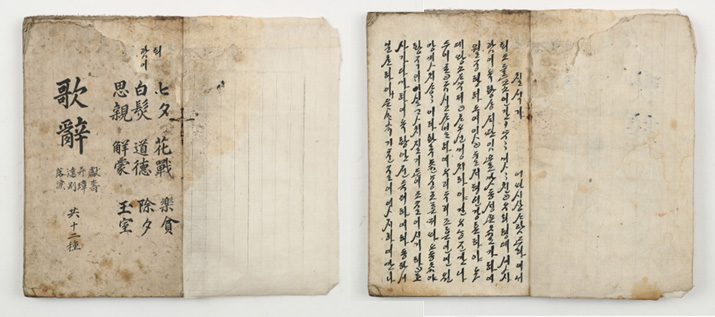 Chilseokga / Late 1800’s / 31.7×21.0㎝
Jiknyeo weaves and waits for July 7 to meet with Gyeonu. The piece represents her happiness when she meets with Gyeonu on the 7th and sadness when she parts with him.
Chilseokga / Late 1800’s / 31.7×21.0㎝
Jiknyeo weaves and waits for July 7 to meet with Gyeonu. The piece represents her happiness when she meets with Gyeonu on the 7th and sadness when she parts with him.
Tahyanggil…
 Tahyanggil… / Early 20th century / 23.5×59.0㎝
It is included in the same scroll with Cheongchunjatanga. She talks about her homesick in Seoul when she moved to Seoul at the age of 16 after graduating from primary school with the help of her parents. In the later half, she talks about sadness from parting with the hometown due to compulsory service for the Second World War and wishes to meet again in the future.
Tahyanggil… / Early 20th century / 23.5×59.0㎝
It is included in the same scroll with Cheongchunjatanga. She talks about her homesick in Seoul when she moved to Seoul at the age of 16 after graduating from primary school with the help of her parents. In the later half, she talks about sadness from parting with the hometown due to compulsory service for the Second World War and wishes to meet again in the future.
Hangeulgasa
 Hangeulgasa / Early 20th century / 17.5×351.0㎝
The lyrics are about lamentation of how Queen Min and Heungseon Daewongun destroyed the country and therefore Samgangoryun fell down as well. As the name of the area in Gagok, Andong is mentioned in the lyrics, the author’s information can be inferred. While she was on a train from Gagok, Andong, in exile, she talks about how Gyeongbuseon and the railroad bridge in Han River let her go, lamenting her situation of leaving the home country.
Hangeulgasa / Early 20th century / 17.5×351.0㎝
The lyrics are about lamentation of how Queen Min and Heungseon Daewongun destroyed the country and therefore Samgangoryun fell down as well. As the name of the area in Gagok, Andong is mentioned in the lyrics, the author’s information can be inferred. While she was on a train from Gagok, Andong, in exile, she talks about how Gyeongbuseon and the railroad bridge in Han River let her go, lamenting her situation of leaving the home country.


A granddaughter who was married and moved to Hahoe Village from the Goseong Yi family sings about the joy of receiving her grandmother’s letter from Manchuria and misfortune of the destroyed country. She talks about her sad feelings for the two times of the asylum of the Goseong Yi family to Manchuria. She also prays for the recovery of the national luck. The situation of the destroyed country is well represented.











